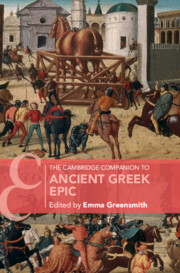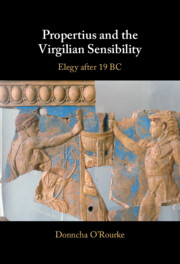Refine search
Actions for selected content:
84 results
Chapter 13 - Ille Ego
- from Part III - Personal Ennius
-
-
- Book:
- Ennius Beyond Epic
- Published online:
- 10 December 2025
- Print publication:
- 18 December 2025, pp 292-314
-
- Chapter
- Export citation
Introduction
-
- Book:
- Nostalgia and National Identity in the British and Irish Modernist Epic
- Published online:
- 27 November 2025
- Print publication:
- 18 December 2025, pp 1-24
-
- Chapter
- Export citation
Chapter 1 - Competing Nostalgias and Irish Identity in James Joyce’s Ulysses
-
- Book:
- Nostalgia and National Identity in the British and Irish Modernist Epic
- Published online:
- 27 November 2025
- Print publication:
- 18 December 2025, pp 25-53
-
- Chapter
- Export citation
Introduction - Ennius Over-Annalized
-
-
- Book:
- Ennius Beyond Epic
- Published online:
- 10 December 2025
- Print publication:
- 18 December 2025, pp 1-12
-
- Chapter
- Export citation
4 - Becoming Distinct
-
-
- Book:
- The Cambridge History of Australian Poetry
- Published online:
- 19 November 2025
- Print publication:
- 11 December 2025, pp 84-99
-
- Chapter
- Export citation
40 - Long Form Poetry from the 1980s to the Present
-
-
- Book:
- The Cambridge History of Australian Poetry
- Published online:
- 19 November 2025
- Print publication:
- 11 December 2025, pp 749-768
-
- Chapter
- Export citation
5 - Anglophone Epics and Ruin Poetry in Eighteenth-Century India
- from Part I - Early Intimations and Literary Genres: 1500–1800
-
-
- Book:
- The Cambridge Companion to British Literature and Empire
- Published online:
- 20 November 2025
- Print publication:
- 04 December 2025, pp 77-92
-
- Chapter
- Export citation

Nostalgia and National Identity in the British and Irish Modernist Epic
-
- Published online:
- 27 November 2025
- Print publication:
- 18 December 2025
Claiming pietas: Vergilian Rhetoric in Valerius Flaccus’ Argonautica
-
- Journal:
- The Journal of Roman Studies , First View
- Published online by Cambridge University Press:
- 15 August 2025, pp. 1-25
-
- Article
-
- You have access
- Open access
- HTML
- Export citation
THE SIMILES OF TRIPHIODORUS
-
- Journal:
- The Classical Quarterly , First View
- Published online by Cambridge University Press:
- 29 July 2025, pp. 1-13
-
- Article
-
- You have access
- Open access
- HTML
- Export citation
Chapter 31 - Epic
- from Part III - Writings
-
-
- Book:
- Percy Shelley in Context
- Published online:
- 17 April 2025
- Print publication:
- 24 April 2025, pp 235-242
-
- Chapter
- Export citation
More of a Question than a Comment: A Response to Modernism, Empire, World Literature, by Joe Cleary
-
- Journal:
- Cambridge Journal of Postcolonial Literary Inquiry / Volume 11 / Issue 3 / September 2024
- Published online by Cambridge University Press:
- 20 February 2025, pp. 317-324
-
- Article
-
- You have access
- Open access
- HTML
- Export citation
3.2 - Folk Genres
- from History 3 - Forms
-
-
- Book:
- The New Cambridge History of Russian Literature
- Published online:
- 31 December 2024
- Print publication:
- 12 December 2024, pp 482-497
-
- Chapter
- Export citation
Chapter 1 - Introduction: Virgil and the Propertian Sensibility
-
- Book:
- Propertius and the Virgilian Sensibility
- Published online:
- 28 November 2024
- Print publication:
- 05 December 2024, pp 1-59
-
- Chapter
- Export citation

The Cambridge Companion to Ancient Greek Epic
-
- Published online:
- 04 December 2024
- Print publication:
- 28 November 2024
TWO EMENDATIONS ON STATIUS, THEBAID BOOK 6
-
- Journal:
- The Classical Quarterly / Volume 74 / Issue 2 / December 2024
- Published online by Cambridge University Press:
- 17 February 2025, pp. 798-799
- Print publication:
- December 2024
-
- Article
- Export citation
VIRGIL AND THE RHESVS ATTRIBUTED TO EURIPIDES: AN UNNOTICED ALLUSION AT AENEID 1.25–7?
-
- Journal:
- The Classical Quarterly / Volume 74 / Issue 2 / December 2024
- Published online by Cambridge University Press:
- 07 March 2025, pp. 611-617
- Print publication:
- December 2024
-
- Article
-
- You have access
- Open access
- HTML
- Export citation

Propertius and the Virgilian Sensibility
- Elegy after 19 BC
-
- Published online:
- 28 November 2024
- Print publication:
- 05 December 2024
3 - Lucian’s Poetics
- from Part I
-
-
- Book:
- The Cambridge Companion to Lucian
- Published online:
- 07 November 2024
- Print publication:
- 21 November 2024, pp 50-77
-
- Chapter
- Export citation
10 - Talk and Text
- from Part IV - Conceptual Contexts
-
-
- Book:
- Texts and Intertexts in Archaic and Classical Greece
- Published online:
- 14 November 2024
- Print publication:
- 21 November 2024, pp 235-255
-
- Chapter
- Export citation
